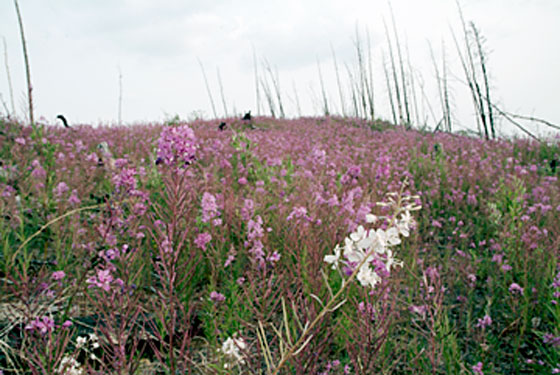
Photo by Whitehorse Star

Photo by Whitehorse Star
The Fireweed, the official floral emblem of the Yukon Territory, was chosen by members of the Yukon Territorial Government on March 27, 1957.
The Whitehorse Star 1957
Yukon Fireweed
The Fireweed, the official floral emblem of the Yukon Territory, was chosen by members of the Yukon Territorial Government on March 27, 1957.
It was made official the following November, when the Ordinance naming the "epilobium angustifolium" as the Yukon flower was passed.
Throughout June, July, and August, the fireweed springs up along the Alaska Highway and every other Yukon road in a never-ending border of purple color.
It covers the scenes of old forest-fire areas, and stretches for miles on the mountain sides. Because it is so common in every part of the Yukon, and because it is so hardy and beautiful, it was a natural choice as a floral emblem.
The fireweed's stalk-type blossoms range in color from orange-scarlet buds to purply-mauve flowers, all in one plant, which sometimes grows to a height of four feet. Occasionally a white one may be seen.
In the far north, its Arctic sister "elipobium latifolium" produces the same lovely flower on a squat four-inch high plant. "Angustifolium" means narrow-leaved; the hardy Arctic plant is wider-leaved.
In order to encourage thoughtful and responsible discussion, website comments will not be visible until a moderator approves them. Please add comments judiciously and refrain from maligning any individual or institution. Read about our user comment and privacy policies.
Your name and email address are required before your comment is posted. Otherwise, your comment will not be posted.
Comments (1)
Up 1 Down 1
Gail Jobb on Feb 1, 2016 at 12:57 pm
I was given a coin for identification. Perhaps you can direct my query to someone for me, or let me know where to inquire. The coin is bronze in color, has the coat of arms on one side; the fireweed on the other side. It has French translations on one side. The diameter is about 2 or 2.5 cm. The person who has it thought it was good for a tank of gas "somewhere". It is certainly an unusual artifact to turn up in the bush in Northern Saskatchewan. Thanks!